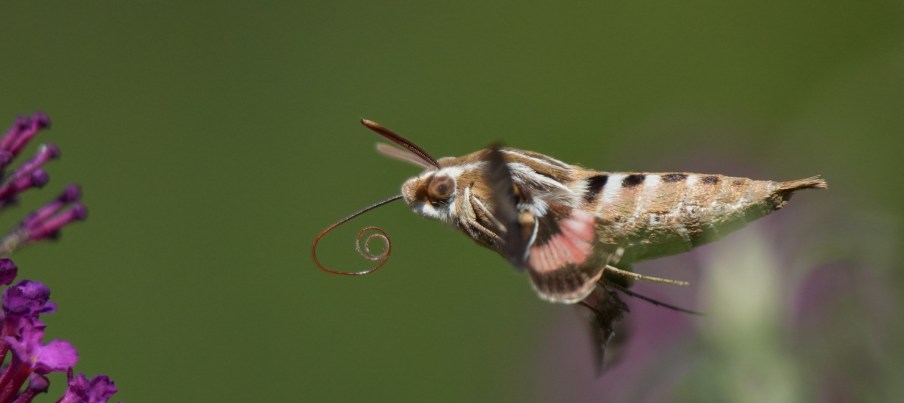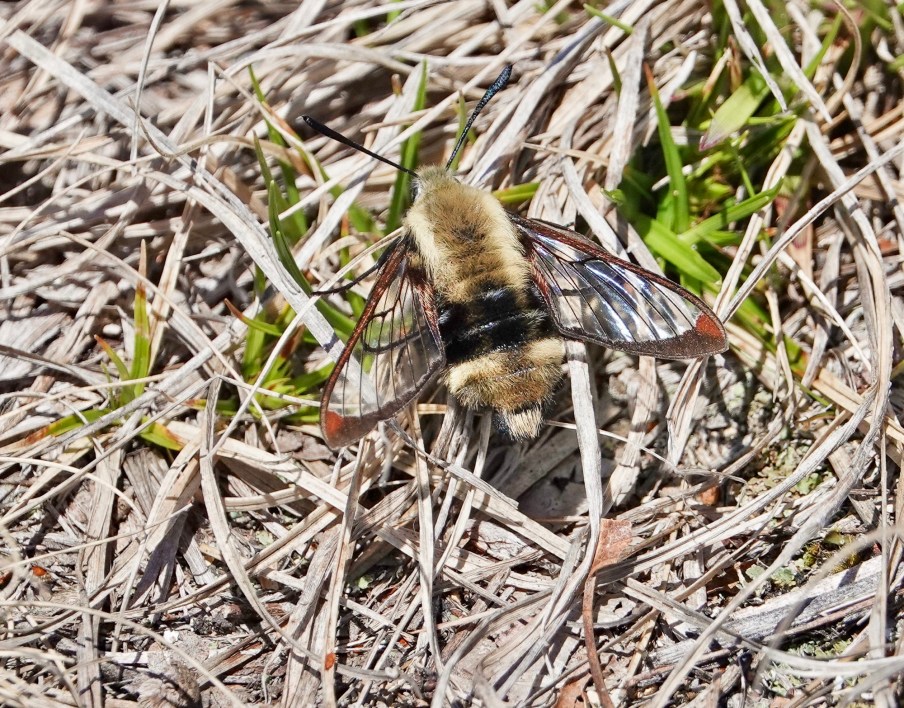Posts in Category: moth
New Mexico! White-lined Sphinx Moth




White-lined Sphinx Moth: Randall Davey Audubon Center, Santa Fe, New Mexico, USA, July 2024 — As I mentioned a week or so ago, the plants at Randall Davey were attracting a lot of Sphinx Moths, certainly the most I have ever seen in one place at one time. I had a lot of fun trying to catch them in the frame of my camera. I found that I had to use the mechanical shutter on the Sony a6700, as the moths’ wings were just the right speed to distort with the silent electronic shutter. 🙁 Not a problem really…just a matter of switching shutters. As above, Sony a6700 with Tamron 50-400 Di iii VC VXD zoom at 600mm equivalent. Program mode with my flight and action modifications. Insect subject recognition and focus. Processed in Photomator.
New Mexico! Hummingbird Moth


Though it is often called a hummingbird moth because it looks and acts like a hummer, it is actually a White-lined Sphinx Moth and it was busy among the flowers at the Randall Davey Audubon Center in the hills above Santa Fe, New Mexico yesterday (two actually). I got to test out the insect subject recognition auto focus on the Sony a6700. It works very well…however I had to switch off “silent shutter” as the rolling shutter effect did strange things to the moth’s wings. Propeller effect for sure. Sony a6700 with Tamron 50-400 Di iii VC zoom at 600mm equivalent. Program mode with my birds in flight and action modifications and Insect Recognition auto focus. Processed in Photomator.
Maine! Hummingbird Clearwing Moth



Hummingbird Clearwing Moth: Kennebunk Plains Conservation Area, York County, Maine, USA, August 2023 — Last week when I went out to check for insects in the Northern Blazing Star bloom on the Kennebunk Plains, I found this Hummingbird Clearwing Moth working the Blazing Star…with a Monarch Butterfly right behind it. What are chances? Clearly better than you might think…as here you have it. There are two Clearwing Moths in Southern Maine, the Hummingbird (this one) and the Snowberry (which has a dark stripe down the side) and I have seen them both on the Plains different years. This is, on the other hand, only my 5th life Clearwing, though I only have photos from 3 of the previous…but I do remember each encounter vividly. This one will be the “one with the Monarch” 🙂 OM Systems OM-1 with the ED 100-400mm zoom at 800mm equivalent. Program mode with my custom birds and wildlife modifications. Processed in Pixelmator Pro. ISO 200 @ f6.3 @ 1/800th.
Bonus: Snowberry Clearwing Moth

Snowberry Clearwing Moth: Kennebunk, Maine, USA, July 2022 — As I mentioned in yesterday’s Day Poem…when I went out for my eTrike ride the other day I was dumping my “old’ water from my water bottle in the hanging plants out front when I saw this Snowberry Clearwing Moth working the blooms. We have two possible Clearwings here in Southern Maine…the Snowberry and the Hummingbird…and I always have to look them up to refresh my memory after seeing one. Maybe one of those times the differences will stick in my head. (You can google it.) Both look, when working flowers, like tiny hummingbirds. Though references say the Hummingbird Clearwing is the more common of the two, I have definitely seen more Snowberries. Sony Rx10iv at 600mm equivalent. Program mode with my custom birds and wildlife modifications and multi-fame noise reduction (definitely not needed in this situation…but the camera was still in that mode when I grabbed it for the Clearwing…and by the time I got it to the correct mode…the moth was gone 🙂 Nominal exposure ISO 200 @ f4 @ 1/500th.
Large Lace Border Moth

Large Lace Border Moth: Kennebunk, Maine, USA — When I got back from my trike ride the other day, this lovely little moth was waiting for me in the ground cover along the foundation of our home. It was settled there, and I was able to put the camera in Macro mode and take this full frame close up at about 108mm equivalent. I did not know what the moth was, so I used the AI identification feature of my FieldGuides Leps app. I was not at all surprised at the name…it is what I would called this moth if I had the naming to do 🙂 Though it is the “large” lace border moth, it is only about an inch wing tip to wing tip. Nikon B700 as above. Shutter program with my custom birds and wildlife modifications. Processed in Polarr and Apple Photos.
Drasteria moth

Drasteria moth (probably Shadowy Arches): Kennebunk Plains Wildlife Management Area, Maine, USA — I found this little moth fluttering close to the ground along the foot trail at Day Brook Pond on the Kennebunk Plains Wildlife Management Area the other day. Some research this morning gets me as far as one of the Drasteria moths, possibly a Shadowy Arches, but I don’t know my moths well enough, or their ranges, to eliminate any of the other Drasterias. I think the Graphic Moth might be more common in Maine, but this one seems to have too much orange. 🙂 If anyone knows better, please leave a comment. Sony Rx10iv at 600mm equivalent from about 4 feet. Program mode with my custom birds and wildlife modifications. Processed in Polarr and Apple Photos. ISO 100 @ f4 @ 1/640th.
A tale of two moths


Eight-spotted Forester and White-striped Black Moths, Emmon’s Preserve, Kennebunkport, Maine, USA. I went out to Emmon’s Preserve yesterday on my eBike, to see about early dragonflies, but mostly to see if the field of Lupine up the road from there was in full bloom yet. I found these two moths in one corner of the meadow above the Land Trust buildings. Two little back moths. There were quite a few of the White-striped Blacks, but I only saw the one Forester. I had to look them both up, as they were new to me. They are distinctive enough so that it was an easy search on the internet. Sony Rx10iv at 600mm equivalent. Program mode with my custom birds and wildlife modifications. Processed in Polarr and Apple Photos.
Snowberry Clearwing Moth

Snowberry Clearwing Moth, Kennebunk Plains Nature Conservancy. Kennebunk, Maine. — We had biking weather (above 60 degrees) over the weekend and I went out to the Kennebunk Plains Nature Conservancy. It has been the Kennebunk Plains Wildlife Management Area for several years, owned by the Nature Conservancy and managed by the Maine Department of Inland Fisheries and Wildlife, but evidently the Nature Conservancy has taken back the management duties this year, or so the new signs and gates would indicate. It is one of the few places where I often see Clearwing Moths. Last year I photographed the Hummingbird Clearwing on the Plains, and this weekend this Snowberry Clearwing was flying inches over the ground. At first I took it for one of those big ground bees, wood bees, bumble bees we get in spring but when I looked closer the clearwings were obvious. It appeared to laying eggs on the short stubble left form last September’s prescribed burn. Sony Rx10iv at 600mm equivalent. Program mode with my custom birds and wildlife modifications. Processed in Polarr and Apple Photos.
Leps in the Blazing Star

I mentioned how impressed I was with the numbers of insects using the endangered Northern Blazing Star boom on the Kennebunk Plains Wildlife Management Area here in southern Maine this week. Here are 4 leps (to add to the White-lined Sphinx Moth posted earlier). Painted Lady, Common Wood-nymph, Monarch, and what I think is a Wandering Gem moth. Something very Gem like anyway. The moth was tiny…it just covered the tip of my finger. Sony RX10iv at 600 and 1200mm equivalent (1200 at 2X Clear Image Zoom). Program mode with my custom birds and wildlife modifications. Processed in Polarr and assembled in Framemagic.
White-lined Sphinx Moth

My friend Stef and I took a loop out through the Kennebunk Plains Wildlife Management Area yesterday to take in, among other things, the last of the Northern Blazing Star bloom. Blazing Star is endangered in Maine and the Plains are one of its last strongholds. I was reminded just how important a resource it is. Besides flocks of busy Goldfinches and Pine Warblers, the Blazing Star along Day Brook Pond was full of insects…butterflies and moths and bees and flies. When I first saw this White-lined Sphinx Moth I took it for one of the Clearwings. I have seen both Snowberry and Hummingbird Clearwings working the Blazing Star in the past. A closer look showed that despite similar size and behavior, this was a different moth. No transparent wings. I had to look it up when I got home. The White-lined Sphinx, like many Hawk moths, is mostly nocturnal, and mostly seen early and late, during dawn and dusk, so I can be forgiven for assuming it was a Clearwing. If I remember correctly, my only other sighting was years ago by artificial light on our back deck, feeding on the potted plants we keep there, when I, like many others, called it a Hummingbird Moth because of its size and behavior. (That name actually belongs to the Clearwing.) The White-lined Sphinx Moth occupies a huge range, all of North America and parts of Central America, and there are apparently known populations in Europe, Asia, and Africa. This one was very cooperative, working the same patch of Blazing Star for 15 minutes or more, and coming in close enough for lots of photos, before zooming off in search of a new patch of flowers. Sony RX10iv at 1200mm equivalent (2x Clear Image Zoom). Program mode with my custom birds and wildlife modifications. Processed in Polarr.